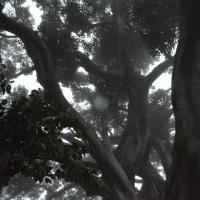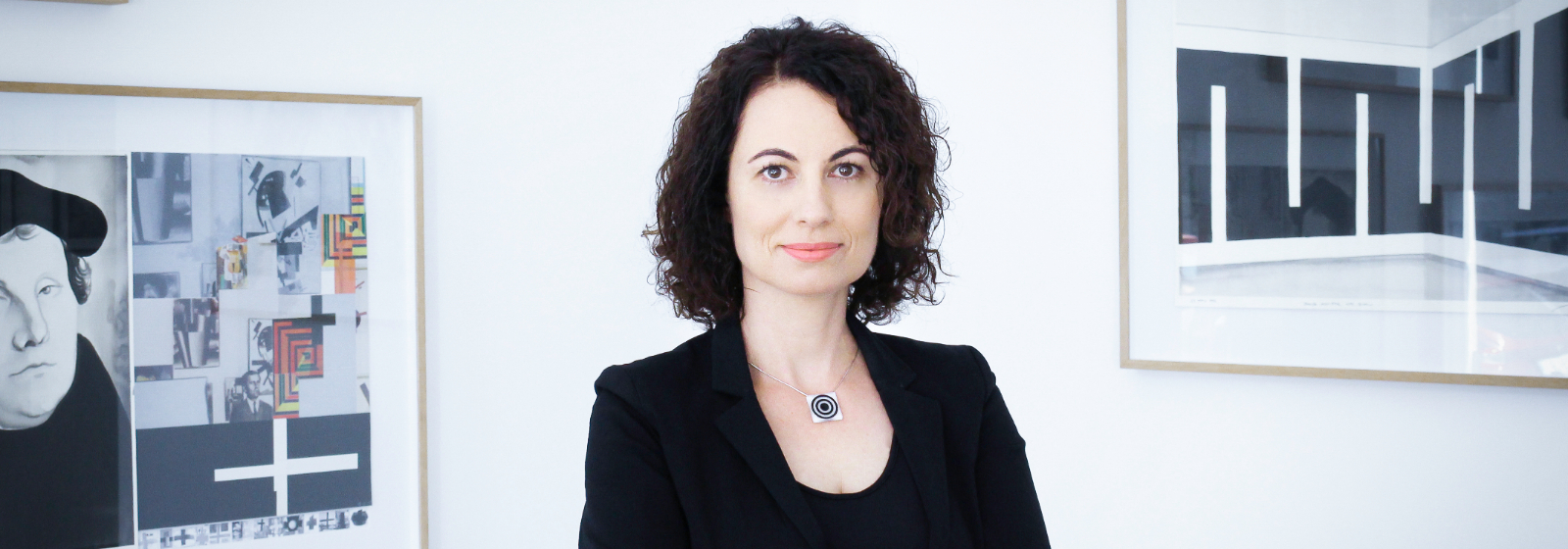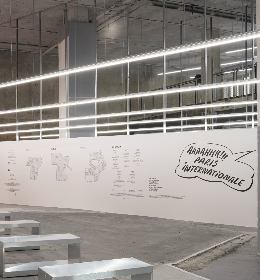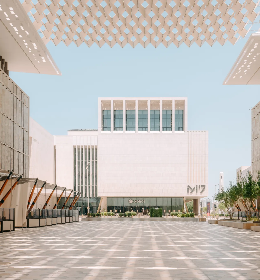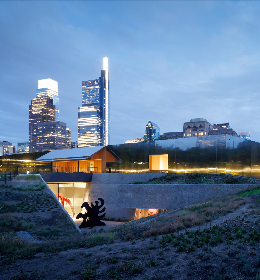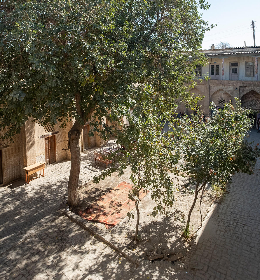With a decade in action, the gallery is well established and this is due to the visionary work of Annamária Molnár, the gallery’s director and founder. In 2013, the gallery received the prestigious Innovation and Creativity Award from F.E.A.G.A. (Federation of European Art Galleries Association), which is meant to honor outstanding galleries and the visible and invisible support they bring to the artists they represent.
I met up with Molnár in Budapest at her gallery to talk about the art market and the current exhibition, which opened recently. Molnár’s background, working in business with an economics degree from Corvinus University, has allowed her to develop her own gallery incrementally. Speaking about the impetus for change from working as an economist to being a gallery director and curator, she explains, “I was really lacking this intellectual excitement that art can give. It’s a very unique business with special rules of the game and strong elements of a cultural mission. However, it’s still a business at the end of the day. We represent artists, we support their career and sell their works. I think it’s something you have to learn step by step over the years, so it was important for me to gain enough experience in the art world as well before establishing the gallery. Therefore I organized exhibitions and projects as a freelance curator, while I still had my job in international real estate and banking companies for about ten years before opening the gallery. When the right moment finally arrived, I also had a strong ambition to do my own business and test myself as an entrepreneur.”

Radenko Milak&Roman Uranjek: 30. December 2018 (Masereel-Matisse), 2018, Mixed Media, 135 x 212 cm, Photo credit: Matija Pavlovec, Courtesy of Ani Molnár Gallery
A city incredibly saturated with culture, Budapest’s greatest wealth is in its museums, with its annual Night of Museums event listing 114 of them covering a broad scope all around the city. With also a variety of galleries such as the white-walled utopias present in all of Europe’s major cities, to the tiny shops and bars that have turned extra rooms into exhibition spaces. Budapest has not yet matched the quantity or stability of its galleries to its museums. Molnár explains about Hungarian collectors and their cultivation as a part of the business of art in Hungary, “We have an active art market with an increasing number of collectors in Hungary. We also have an art fair, Art Market Budapest, and an annual gallery weekend. Despite all of these initiatives, I think this market is still relatively small; therefore the gallerists have to be constantly active in working on the development of the market. It is interesting to see that many of those collectors who were very active when I started the gallery are not in the buying mood anymore, but at the same time there is a constant emergence of new collectors, especially from the younger generations. The educational work of the galleries will always remain more important in Eastern European countries than in major art capitals to compensate for the 4 lost decades in the art market caused by the socialist era. We constantly need to educate collectors who are just thinking about starting a collection or are interested in buying contemporary art. I think that there is a lot of work still to be done here.”

Radenko Milak&Roman Uranjek: DATES 9, interior photo, photo credit: Eszter Lázár, Courtesy of Ani Molnár Gallery
Several artists of the gallery have received multiple awards and opportunities, which have brought them into an international spotlight from different angles and prismatic relationships over the past few years. I asked Molnár to explain her goals as a gallery director in terms of developing and supporting the artists: these are goals which mark the innovation and creativity that sparked the attention of the F.E.A.G.A. award 2013, and have continued to be of importance up until today.
Molnár extrapolates upon this history and focus, “From the very beginning it was highly important for me to go abroad and establish a constant presence in the international art world. For a gallery one of the obvious choices is to participate in international art fairs, because this is one of the most effective promotions we can give to our artists, as they get really great visibility and contacts there. These platforms provide regular possibilities to meet curators and different art professionals as well as to give the artists the opportunity to get invitations for residency programs or to receive awards. These opportunities happened on numerous occasions, but I would just highlight two recent successes: one was Sári Ember, who received the Campari Award at Artissima in Torino in 2017, while the other was Péter Forgács, who got the Art Acquisition Award at LOOP Barcelona video fair in 2018.” For both well known artists like Forgács and for emerging artists, like Ember, it is beneficial to receive these awards from different aspects. For the former, Molnár reveals that this enabled him to have his work added to the MACBA: Museu d’Art Contemporani de Barcelona, which was the first work of his acquired for its esteemed collection. For Sári Ember, Molnár emphasizes, “it gave her prestige and attention, but the most important thing was that she got the possibility to have a solo exhibition in Milan at the Campari Gallery curated by Ilaria Bonacossa. If we persistently want to promote the artists, whose aim is to have an international career, it is very important to have an active presence abroad, as I don’t think that any of the local markets and art scenes can provide all the necessary possibilities for the artistic development of these ambitious artists.” The relationship of a gallery being truly embedded in the international art world is of tantamount importance to Molnár and she speaks of the partnership between the artists and the galleries as a means to equally grow and prosper. She confirms what is often said in the art world, “Cultivating personal contacts is very important,” and Molnár also reassures us that, “If an artist is good and persistent, the possibilities will come.”
In terms of advice and thoughts on emerging and established artists looking to expand their marketability, Molnár references a new book recently published giving advice for Hungarian artists about the market. Its title is Being an Artist - Contemporary Booklet for Artists, which includes an essay she has written along with other advice from local art professionals. “In Hungarian art universities there is not enough focus on lecturing about the art market and how to cooperate with galleries. My chapter in the book is about collecting from the artist’s point of view and also about how to approach a gallery, what is the advantage of being part of a gallery’s programme. For artists who really have the ambition to be present internationally, it is essential to have gallery representation because the gallery can provide so much extra support, which is not really possible in today’s art scene alone. However, being part of a gallery’s roster does not solve everything; it is a possibility; it is a good opportunity; it is good visibility because of the exhibitions and fairs. On the other hand, the artists’ own initiatives are also important. They should exhibit in non-profit institutions, applying for residencies and scholarships, working on many projects,” explains Molnár.
The gallery also represents Tamás Waliczky, who is this year’s artist shown in the Hungarian Pavilion in the Giardini at the Venice Biennale. “I am very happy for Tamás Waliczky having gotten the possibility to exhibit at the Venice Biennale this year. He has had a great career since the 80s as a pioneer in new media art. He is one of those artists who started to work with the computer, and by 1989 he had already won the prestigious Ars Electronica Award.” Molnár opens up about the parallel development of this exhibition in Venice and his first show at Ani Molnár Gallery, “It was his first solo exhibition in a private gallery in Hungary and the application process for the biennale was at exactly the same time as he had this exhibition, so what he showed at the gallery a year ago was the basis for his exhibition at the Venice Biennale.”
The current exhibition at the gallery depicts a collaboration between the artists Radenko Milak & Roman Uranjek, entitled "DATES 9". Molnár was asked to curate a previous show of their works in Ljubljana in 2016 in Barbara Ceferin’s Galerija Fotografija, where she met the artists for the first time. Radenko Milak represented Bosnia and Herzegovina at the 57th Venice Biennale with the project entitled, University of Disaster, on which he collaborated with various other artists, including Roman Uranjek, who is one of the founders of the legendary IRWIN group. Both artists hail from former Yugoslavia, although they are from different generations and locations. The artists discovered some parallels between themselves, with a consistent daily process of production over the years in their artistic work, which inspired them to begin collaborating in 2014. In this exhibition, their very first collaborative work is presented along with many new works and some individual pieces by both artists, giving a greater context to their artistic oeuvre both independently and as part of a collaboration.
Molnár explains their collaborative process, “Radenko Milak paints some moments from the history or art history connected to a specific day. He struggles against personal and historical amnesia by collecting and recreating emblematic images that depict crucial events. He sends the paintings to Roman Uranjek who reacts to Milak’s works with a collage. Uranjek selects a piece as a basis from his special archive, “At least one cross a day,” which he started on January 1st, 2002 when the euro was introduced in Europe.”

Radenko Milak&Roman Uranjek: 13. June 2007 (Ad Reinhardt), 2018, Mixed Media, 70,5 x 90 cm, Photo credit: Matija Pavlovec, Courtesy of Ani Molnár Gallery
The curated project in the gallery focuses on photo documentations from the twentieth century, which the artists have found, manipulated, and contextualized through their reflective process and collaboration, with their art as a political and sociological witnessing to contemporaneous moments in their own artistic development and the Hungarian historical past. The two artists are open to the interpretation of the viewer with the work, but here they give clues to their process with various representations in small and larger format on paper, even with hidden copies of original references attached to the verso side of the artworks. “They don’t want to give a precise explanation — they encourage the audience to think about it like a puzzle,” explains Molnár.
I was wondering about the concerns that galleries have and some of the challenges that they encounter over time, including financial responsibilities, so I asked what are some of the stumbling blocks. “The gallery business is not an easy one and it’s very risky and volatile from many aspects,” Molnár responds. “One focus of the gallery remains the younger generation of artists. When you start with an emerging artist you never know how the artist will develop. I had some exceptionally good experiences, but I had some less positive ones as well with some artists who did not grow as expected. The art market in Hungary is still not strong enough to produce a turnover that could support continuous investments in catalogues, art fairs and other promotional activities. Generally, the position of smaller and mid-level galleries is the most difficult all around the world, while the mega galleries perform very well, so this problem is not confined just to our region. Also, I believe that sound institutional background, the joint events and cooperation between the different players, may contribute a lot to nurture a vital local art scene, and that is something we should do much better in Hungary, too.” Molnár advises, “If someone wants to be a gallerist, then obviously, there should be some extra motivation and spirit and most importantly a passion for art.”



